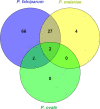Plasmodium malariae contributes to high levels of malaria transmission in a forest-savannah transition area in Cameroon
- PMID: 36698132
- PMCID: PMC9875470
- DOI: 10.1186/s13071-022-05635-7
Plasmodium malariae contributes to high levels of malaria transmission in a forest-savannah transition area in Cameroon
Abstract
Background: Malaria control efforts are highly skewed towards Plasmodium falciparum while overlooking other Plasmodium species such as P. malariae. A better understanding of the role of Plasmodium species other than P. falciparum is needed to strengthen malaria elimination initiatives. The aim of the present study was to elucidate the contribution of P. malariae to malaria transmission in Cameroon.
Methods: The study was conducted in the Ngatti Health District, a forest-savannah transition area in the Adamawa Region, Cameroon. A total of 497 individuals aged from 1 to 85 years were diagnosed with malaria in November 2020 using a rapid diagnostic test (RDT) and microscopy. Adult mosquitoes were collected between September 2019 and March 2020 by indoor aspiration and identified morphologically and molecularly. The infection status of Plasmodium spp. was also determined by quantitative PCR, and dried blood spots were collected from 156 participants with the aim to detect different Plasmodium species by nested PCR.
Results: The overall Plasmodium prevalence was 50.3%, 51.8% and 64.7%, as detected by microscopy, the RDT and PCR, respectively. Based on the PCR results, P. falciparum was the most prevalent species (43%); followed by co-infections P. falciparum/P. malariae (17%), P. falciparum/P. ovale (1.3%), P. falciparum/P. ovale/P. malariae (1.3%); and then by P. malariae mono-infection (2.5%). The same trend was observed using microscopy, with 35% of participants infected with P. falciparum, 11% co-infected with P. falciparum/P. malariae and 4% infected with P. malariae. The prevalence and parasite density of malaria infection varied significantly with age group (P < 0.05), with the highest prevalence rate observed in children aged 6-10 years (P = 0.0001) while the density of Plasmodium infection increased significantly in children aged < 5 years compared to the other age groups (P = 10-3). Among the 757 Anopheles mosquitoes collected, 737 (97.35%) were An. funestus sensu stricto, 15 (1.9%) were An. gambiae and 5 (0.6%) were An. hancocki. The Plasmodium species recorded at the head/thorax level were P. falciparum and P. malariae, with a sporozoite infection rate of 8.4%; the highest sporozoite infection rate was recorded at Mibellon village (13.6%).
Conclusion: The results of this study reveal the significant contribution of P. malariae, in addition to P. falciparum, to the high malaria transmission rate in this region. These findings highlight the need to deploy initiatives to also tackle this Plasmodium species to eliminate malaria in the region.
Keywords: Malaria; P. falciparum; P. malariae; P. ovale; Reservoir.
© 2023. The Author(s).
Conflict of interest statement
The authors declare that they have no competing interests.
Figures




Similar articles
-
Epidemiological and entomological studies of malaria transmission in Tibati, Adamawa region of Cameroon 6 years following the introduction of long-lasting insecticide nets.Parasit Vectors. 2021 May 8;14(1):247. doi: 10.1186/s13071-021-04745-y. Parasit Vectors. 2021. PMID: 33964974 Free PMC article.
-
Persistent transmission of Plasmodium malariae and Plasmodium ovale species in an area of declining Plasmodium falciparum transmission in eastern Tanzania.PLoS Negl Trop Dis. 2019 May 28;13(5):e0007414. doi: 10.1371/journal.pntd.0007414. eCollection 2019 May. PLoS Negl Trop Dis. 2019. PMID: 31136585 Free PMC article.
-
Probing the composition of Plasmodium species contained in malaria infections in the Eastern region of Ghana.BMC Public Health. 2019 Dec 2;19(1):1617. doi: 10.1186/s12889-019-7989-1. BMC Public Health. 2019. PMID: 31791319 Free PMC article.
-
Global trend of Plasmodium malariae and Plasmodium ovale spp. malaria infections in the last two decades (2000-2020): a systematic review and meta-analysis.Parasit Vectors. 2021 Jun 3;14(1):297. doi: 10.1186/s13071-021-04797-0. Parasit Vectors. 2021. PMID: 34082791 Free PMC article.
-
Review of malaria situation in Cameroon: technical viewpoint on challenges and prospects for disease elimination.Parasit Vectors. 2019 Oct 26;12(1):501. doi: 10.1186/s13071-019-3753-8. Parasit Vectors. 2019. PMID: 31655608 Free PMC article. Review.
Cited by
-
Plasmodium vivax in Sub-Saharan Africa: An Advancing Threat to Malaria Elimination?Am J Trop Med Hyg. 2023 Aug 28;109(3):497-498. doi: 10.4269/ajtmh.23-0523. Print 2023 Sep 6. Am J Trop Med Hyg. 2023. PMID: 37640286 Free PMC article. No abstract available.
-
Differential ex vivo susceptibility of Plasmodium malariae and Plasmodium falciparum clinical isolates from Ghana and Mali to current and lead discovery candidate antimalarial drugs.Microbiol Spectr. 2025 Apr;13(4):e0217624. doi: 10.1128/spectrum.02176-24. Epub 2025 Mar 10. Microbiol Spectr. 2025. PMID: 40062863 Free PMC article.
-
Population Genomics of Plasmodium malariae from Four African Countries.medRxiv [Preprint]. 2024 Sep 9:2024.09.07.24313132. doi: 10.1101/2024.09.07.24313132. medRxiv. 2024. PMID: 39314932 Free PMC article. Preprint.
-
Histidine-rich protein (hrp) 2-based RDT false-negatives and Plasmodium falciparum hrp 2 and 3 gene deletions in low, seasonal and intense perennial transmission zones in Cameroon: a cross - sectional study.BMC Infect Dis. 2024 Sep 30;24(1):1080. doi: 10.1186/s12879-024-09935-4. BMC Infect Dis. 2024. PMID: 39350071 Free PMC article.
-
Malaria Species Positivity Rates Among Symptomatic Individuals Across Regions of Differing Transmission Intensities in Mainland Tanzania.J Infect Dis. 2024 Apr 12;229(4):959-968. doi: 10.1093/infdis/jiad522. J Infect Dis. 2024. PMID: 37992117 Free PMC article.
References
-
- WHO. World malaria report 2015. https://apps.who.int/iris/handle/10665/200018. Accessed 15 Feb 2022.
-
- Ross A, Killeen G, Smith T. Relationships between host infectivity to mosquitoes and asexual parasite density in Plasmodium falciparum. Am J Trop Med Hyg. 2006;75(2 Suppl):32-7. 10.4269/ajtmh.2006.75.32. - PubMed
MeSH terms
Grants and funding
LinkOut - more resources
Full Text Sources
Medical
Miscellaneous

